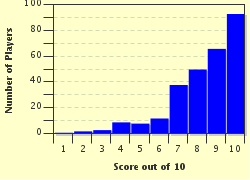Quiz Answer Key and Fun Facts
1. If you saw this imaginary creature with the head and wings of an eagle and the body of a lion, what would you be looking at?
2. According to Homer's "Iliad", this imaginary creature is "a thing of immortal make, not human lion-fronted and a snake behind, a goat in the middle, and snorting out the breath of the terrible flame of bright fire". What is this imaginary creature?
3. We have all heard of that beautiful imaginary creature, the Unicorn, that resembles a beautiful white horse with a spiralling, pointed horn coming out of its forehead, and sometimes with a goat-like beard. According to legend, what is the best way to catch a unicorn?
4. This next imaginary creature had the head, chest and arms of a man and the legs and rest of the body of a horse. What is this creature that was very prominent in Greek mythology?
5. What is the imaginary creature, the Hydra?
6. This next imaginary creature is a very large sea monster with many arms that attacked ships and ate the crew. What is the name of this legendary creature?
7. This next imaginary creature, the Basilisk, has been mentioned many times in legend and writings of many famous people through the ages. They have been described as very large and also small, but there is one ability they all have in common. Do you know what it is?
8. Medusa is the next imaginary creature. Do you know how she, and her two sisters, were referred to?
9. The next imaginary creature is the Minotaur. Do you know what this creature looked like?
10. What is the name of this last imaginary creature who always rose from ashes?
Source: Author
wenray
This quiz was reviewed by FunTrivia editor
looney_tunes before going online.
Any errors found in FunTrivia content are routinely corrected through our feedback system.

